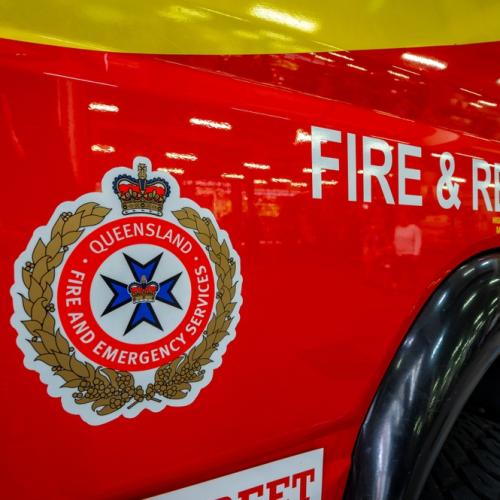UPDATE @ 10.00 AM by Monique St Clair | A tsunami warning for Queensland’s coastline has now been cancelled as the treat from an underwater volcano eases.
The blast went off late yesterday near the coastline of Tonga, causing massive wave surges to the island nation.
Other countries including Australia, New Zealand, Japan and the United States issued warnings to their coastal communities.
Australia’s remained in place through the night and for much of the morning from Sandy Cape to Point Danger.
Queensland’s alert has now been cancelled.
“A tsunami was generated by the eruption of HUNGA TONGA-HUNGA HA’APAI near TONGA ISLANDS,” the latest advice from the Bureau reads.
“The main tsunami waves have now passed all expected QUEENSLAND locations.
“Small unusual tsunami waves may continue but are NO LONGER expected to be dangerous, however a Hazardous Surf Warning is still in effect for the Fraser Island Coast, Sunshine Coast and Gold Coast waters due to Ex-Tropical Cyclone Cody.
“TSUNAMI WARNINGS for QUEENSLAND are therefore CANCELLED.
“No further updates will be issued unless the situation changes,” it reads.
EARLIER @ 6.30 AM, January 16 | Australia’s east coast, including the Gold Coast, remains under a Marine Tsunami Warning after an underground volcano struck near Tonga last night.
The Bureau’s advice remains unchanged as of 6.30 am, warning of the possibility of dangerous rips, waves and strong ocean currents, and some localised overflow onto the immediate foreshore.
The warning came into place around 8.00 pm last night after two eruptions were recorded near Tonga.
“While evacuations are not necessary for Marine Threat areas, people in these areas are advised to get out of the water and move away from the immediate water’s edge,” the Bureau’s latest warning reads.
It’s prompted tsunami warnings around the pacific, including for New Zealand, Japan, Fiji and the United States.
Footage has emerged of large waves surging past the shores on the pacific island nation of Tonga.
Residents sought higher ground and local media reported that the King was even evacuated.
Related article: Powerful tsunami waves sweep Tonga’s shoreline after underground volcano erupts
Back home in Australia, the full effects of the tsunami on our shoreline won’t be known until a little later in the morning.
“We have seen at least a wave just under 1.3 metres for Norfolk Island, it was recorded at the buoy near there,” Grace Legge from the Bureau said.
“We’ve also seen the start of those waves coming through on the east coast as well being observed as some unusual coastal activity as well.”
The NEXT UPDATE will be issued by 8:18 AM AEST on Sunday 16 January 2022
In addition for the Gold Coast, a hazardous surf warning remains in place.
“Surf and swell conditions are expected to be hazardous for coastal activities such as rock fishing, boating, and swimming in the following areas,” the Bureau warns for Sunday, January 16.
All beaches from Rainbow Beach (near Gympie) south to Rainbow Bay at the border are closed today.
❌ BEACH CLOSURES ❌
All beaches from #RainbowBeach (near Gympie) south to #RainbowBay (QLD/NSW border) are closed today due to a current marine alert from the @BOM_Qld.
Conditions are unusual and unstable. SLSQ services are asking the general public to not enter the water. pic.twitter.com/YGVnFzbd8S
— Surf Life Saving Queensland (SLSQ) (@lifesavingqld) January 15, 2022
EARLIER @ 8.00 PM, January 15, by Shanee Dobeson | A marine tsunami warning has been issued for parts of the east coast of Australia, including the Gold Coast, after a giant underwater volcano erupted near the Tonga Islands.
The Hunga-Tonga-Hunga-Ha’apai volcano flared up on Saturday evening (local time), sending large waves crashing into the Pacific country of Tonga.
As a result, Australia’s Bureau of Meteorology has warned there is now a tsunami threat to Queensland’s marine environment.
“A threat to the marine environment of dangerous rips and waves, strong ocean currents and some localised overflow onto the immediate foreshore exists from Sandy Cape to Point Danger including Fraser Island Coast, Sunshine Coast Waters, Moreton Bay and Gold Coast Waters,” BOM warned.
The tsunami threat is predicted to hit Surfers Paradise anytime after 8.00pm and will “persist for several hours”, according to the weather bureau.
“People are strongly advised to get out of the water and move away from the immediate water’s edge of beaches, marinas, harbours, coastal estuaries and rock platforms,” BOM said.
“Boats in harbours, estuaries or shallow coastal water should return to shore.
“Vessels already at sea should stay offshore in water at least 25 metres deep until further advised.”
Marine Threat to #NSW, #QLD, #TAS, #VIC, #MacquarieIsland. Land threat to #LordHoweIsland, #NorfolkIsland. #Tsunami Warning after volcanic eruption near TONGA ISLANDS. Latest info here: https://t.co/Tynv3ZQpEq. pic.twitter.com/hg9aY4Dy8n
— Bureau of Meteorology, Australia (@BOM_au) January 15, 2022
People are being urged not to go to the coast to watch the tsunami as there is the possibility of “dangerous, localised flooding of the immediate foreshore”.
“Tsunami waves are more powerful than the same size beach waves,” the Bureau of Meteorology said.
“There will be many waves and the first wave may not be the largest. Take care in other coastal areas where low-level effects may be observed.”
It’s not yet known if any Australians in Tonga have been injured, however the Federal Government has confirmed they are liaising with their counterparts.
“Tonga is part of our Pacific family and our thoughts are with the entire community dealing with the impact of the volcanic eruption and tsunami,” a spokesperson for the Australian Government said.
“The Prime Minister and Minister for Foreign Affairs are monitoring the situation and Australia stands ready to provide support to Tonga if requested.
“Initial assessments are still underway and DFAT is working to ensure Australians in Tonga are safe and accounted for.”
Ongoing information and details can be found here.










